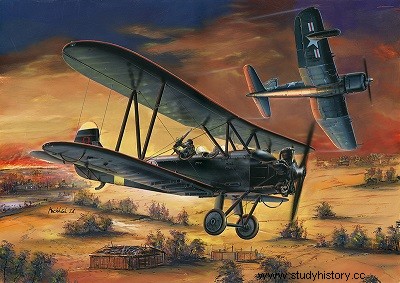
The fighters were first sent against the anti-aircraft batteries concentrated around the objective. This attack carried out, the real raid could begin either with attack and tactical support aircraft, or with Superfortresses flying at 5000 m altitude. To cut a single bridge thus required several attacks (with the possible losses) and hundreds of bombs and guided rockets. In 1951, B-29s intervened with the "Razon" and "Tazon" guided bombs (the latter weighing just over five tons) without much success. The Communists showed themselves masters in the art of camouflage their movements; they managed to organize the logistics with extraordinary discretion and immediately repaired the damage caused by the aircraft. In particular, they used submerged structures and mobile pontoons to replace destroyed bridges.
Although radar and electronic countermeasures (ECM) techniques have made little progress since the end of of World War II, many operations in Korea took place at night. The Americans found night operations more conducive to the B-29s, which were painted matte black. On the other hand, the Communists often took advantage of the night to speed up their logistical movements and the repair of various damages. Night attacks were often prepared by C-47s (DC-3s) tasked with illuminating targets with rockets. In 1952, B-26 Invaders illuminated their targets using a very powerful searchlight, but this technique was quickly abandoned:the aircraft so well signaled was unmissable for the DCA! In 1952 also, one noticed the very great communist progress in the field of radars:the losses of B-29 rose quickly to a level as high in the night missions as in those of day.
Allied bases remained poorly defended against possible air attacks. A handful of communist pilots obtained, at night, results often disproportionate to the importance of the attack. Some old PO-2 biplanes, dating from 1926, carried out these raids. Expensive jet planes were thus destroyed by these venerable ancestors bumping at 150 km/h:their slowness was such that it became an advantage! The PO-2s were indeed very difficult to intercept for jet planes flying at least twice as fast as them, and almost never having time to adjust their target. One day, during a fight which pitted him against one of these planes – which he shot down, moreover – an F-94C slowed down too much and, unbalanced, crashed on the ground, killing its crew.
